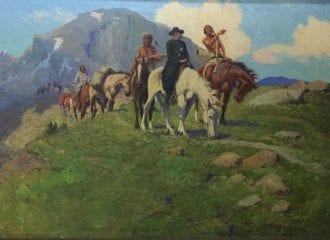The Art of Edward Borein & E. W. “Bill” Gollings

The Brinton Museum (Big Horn, WY) presents The Art of Edward Borein & E. W. “Bill” Gollings on exhibit in the Jacomien Mars Reception Gallery beginning July 4th. Highlighting prints, drawings and paintings by Edward Borein (1872-1945) and Bill Gollings (1878-1932) from The Brinton Museum’s permanent collection and oils by Bill Gollings on loan from Whitney Benefits, this exhibition includes nearly forty works by these two well-known, talented artists endearingly familiar to the American West and its unique history.
Born in San Leandro, California, during the era of cattle drives along the scenic California Western Coast, Edward Borein was a working cowboy who knew the cowboy life from atop a saddle. He learned the art of riding and ranch work from seasoned ranch hands and Mexican vaqueros. Among his extensive cowboy experiences was a six months stint on the sprawling Hacienda Babicora in Chihuahua in Mexico. Establishing a career as an accomplished Western artist in New York City with a studio there led Borein to a friendship with Goelet and Edith Gallatin who brought him out to the newly established Gallatin ranch in Big Horn in 1911. In later years they would introduce him to Bradford Brinton. The Brinton Museum’s Quarter Circle A Ranch House boasts an original Borein frieze in 4 parts telling of Plains Indians who once called this land home and of a time when cowboys drove cattle by the tens of thousands from Texas across the Great Plains to Colorado, Wyoming and Montana. The museum’s permanent collection and art loans include numerous works by Borein, a selection of which portray cowboys and pack horses, caballeros and cow pokes, and are included in The Brinton Museum’s current exhibition.
Born in Pierce City, Idaho, E. W. “Bill” Gollings spent two years of his childhood in Idaho and then lived with his grandmother in Michigan following his mother’s death in 1880. In 1896, he joined his brother, DeWitt, as a working cowboy on his ranch in Rosebud, Montana, and worked on various ranches in southern Montana and northern Wyoming. In addition to a love of the cowboy life, Gollings embraced a passion for art. Due in large part to the encouragement of his brothers, DeWitt and Oliver, and also, Mrs. Marion White, editor of the Chicago Fine Art Journal, Gollings eventually received an art scholarship at the prestigious Chicago Academy of Fine Arts. He later took up residence in Sheridan (WY) and is best known for his oils depicting cowboys and bucking broncs, ranch life and the history of the region. His home and studio at the time were located at the site of what is today Henry A. Coffeen Elementary School. One of Gollings’ historically important works is a large oil entitled, Father DeSmet Learns the Water Courses from the Indians, painted in 1928, on exhibit loan by Whitney Benefits. The Verendryes, depicting the French Verendrye Brothers with a tribe of American Indians during their 1742 journey to the Rocky Mountains, is also on loan by Whitney Benefits. Part of The Brinton’s permanent collection, Wrangling Horses on the Quarter Circle A, once hung in Bradford Brinton’s library above his writing desk. Mirroring the view of the Bighorn Mountains in the distance, Gollings’ oil painted in en grisaille style depicts a slice of everyday ranch life, riding and herding cattle on a summer afternoon. Certainly a scene familiar to the Quarter Circle A.
